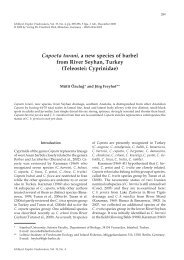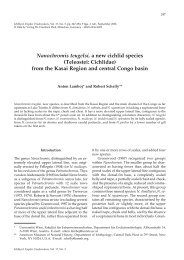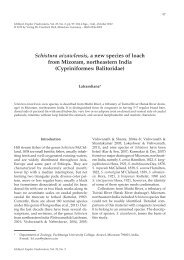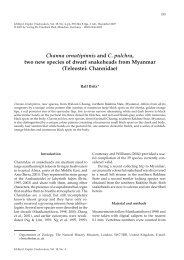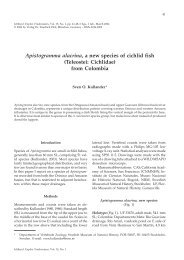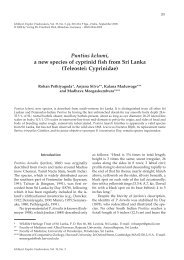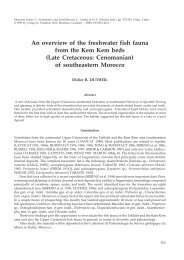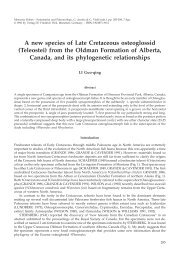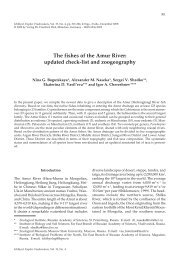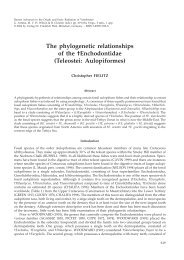Schistura udomritthiruji, a new loach from southern Thailand ...
Schistura udomritthiruji, a new loach from southern Thailand ...
Schistura udomritthiruji, a new loach from southern Thailand ...
Create successful ePaper yourself
Turn your PDF publications into a flip-book with our unique Google optimized e-Paper software.
319<br />
Ichthyol. Explor. Freshwaters, Vol. 20, No. 4, pp. 319-324, 5 figs., 1 tab., December 2009<br />
© 2009 by Verlag Dr. Friedrich Pfeil, München, Germany – ISSN 0936-9902<br />
<strong>Schistura</strong> <strong>udomritthiruji</strong>,<br />
a <strong>new</strong> <strong>loach</strong> <strong>from</strong> <strong>southern</strong> <strong>Thailand</strong><br />
(Cypriniformes: Nemacheilidae)<br />
Jörg Bohlen* and Vendula Šlechtová*<br />
<strong>Schistura</strong> <strong>udomritthiruji</strong>, <strong>new</strong> species, is described <strong>from</strong> streams draining to the Andaman Sea in <strong>southern</strong> <strong>Thailand</strong><br />
between Takua Pa and Ranong. It is distinguished <strong>from</strong> congeners by the following characters: dark bars on the<br />
body much thinner in the anterior half of the body than in the posterior half; 9+8 branched rays in the caudal fin;<br />
males with suborbital flap; lateral line ends above base of anal fin; caudal fin hyaline and dark bars on posterior<br />
half of body more than twice as wide as interspaces.<br />
Introduction<br />
The genus <strong>Schistura</strong> is the largest genus within<br />
the family Nemacheilidae, containing at present<br />
about 190 nominal species. They are typically<br />
found amongst stones in moderately to fast flowing<br />
streams and rivers in foothill to mountainous<br />
habitats. The distribution area of the genus<br />
stretches <strong>from</strong> the Near East through the Indian<br />
subcontinent until Vietnam and <strong>southern</strong> China<br />
(Bânârescu, 1991). Except S. maculiceps <strong>from</strong> the<br />
Kapuas basin on Borneo, the <strong>southern</strong> margin of<br />
the distribution area is in the northern Malay<br />
Peninsular, <strong>from</strong> where two species, S. geisleri and<br />
S. robertsi, were reported. In recently collected<br />
material <strong>from</strong> <strong>southern</strong> <strong>Thailand</strong> we found a species<br />
of <strong>Schistura</strong> that is <strong>new</strong> to science and is described<br />
below.<br />
Material and methods<br />
The specimens were either fixed in 4 % formaldehyde<br />
and later transferred into 70 % ethanol<br />
for storage (ZRC 51724, ZRC 51725) or fixed and<br />
stored in 96 % pure ethanol (IAPG A2546-2552,<br />
A2455-2459, A1129-1131, A1780, CMK 21704,<br />
CMK 21705). All measurements and counts follow<br />
Kottelat (1990). Measurements were made pointto-point<br />
with dial callipers to the nearest 0.1 mm.<br />
Drawings were done using a camera lucida on<br />
an Olympus SZX7 stereomicroscope. Collection<br />
abbreviations: CMK, Collection of Maurice Kottelat,<br />
Cornol, Switzerland; IAPG, Institute of<br />
Animal Physiology and Genetics, Laboratory of<br />
Fish Genetics, Libechov, Czech Republic; ZRC,<br />
Zoological Reference Collection, Raffles Museum<br />
of Biodiversity Research, Department of Biological<br />
Sciences, National University of Singapore,<br />
Singapore.<br />
* Institute of Animal Physiology and Genetics, Academy of Sciences of the Czech Republic, Rumburská 89,<br />
277 21 Libechov, Czech Republic. E-mail: bohlen@iapg.cas.cz<br />
Ichthyol. Explor. Freshwaters, Vol. 20, No. 4
320<br />
Fig. 1. <strong>Schistura</strong> <strong>udomritthiruji</strong>, IAPG A2546, 40.1 mm SL; <strong>Thailand</strong>: Ranong Prov.: stream at Kapoe.<br />
<strong>Schistura</strong> <strong>udomritthiruji</strong>, <strong>new</strong> species<br />
(Figs. 1-2)<br />
Holotype. ZRC 51724, 35.3 mm SL; <strong>Thailand</strong>:<br />
Ranong Prov.: small stream draining into Andaman<br />
Sea upstream of Kapoe; 09°34'14" N 98°41'<br />
40" E; J. Bohlen & V. Šlechtová, 6 Apr 2007.<br />
Paratypes. ZRC 51725, 35, 24.4-47.8 mm SL; same<br />
data as holotype. – IAPG A2546-2552, 7, 25.7-<br />
38.8 mm SL; same data as holotype. – IAPG<br />
A2455-2459, 4, 28.5-32.2 mm SL; <strong>Thailand</strong>: Phang<br />
Nga Prov.: Takua Pa R., ca 10 km upstream of<br />
Takua Pa; 08°46'1540" N 98°26'1340" E; J. Bohlen<br />
& V. Šlechtová, 5 Apr 2007.<br />
Additional material (non-types). IAPG A1129-1131, 3,<br />
31.8-32.7 mm SL; CMK 21704, 2, 32.2-33.7 mm SL; <strong>Thailand</strong>:<br />
Phang Nga Prov.: surrounding of Takua Pa; IAPG<br />
A1780, 1, 39.3 mm SL; CMK 21705, 1, 39.7 mm SL;<br />
<strong>Thailand</strong>: Phang Nga Prov.: no further data.<br />
Diagnosis. <strong>Schistura</strong> <strong>udomritthiruji</strong> belongs to a<br />
group of <strong>Schistura</strong> in which the predorsal dark<br />
bars are much thinner than the posterior ones. It<br />
is distinguished <strong>from</strong> all other species in this<br />
group by the combination of the following characters:<br />
9+8 branched rays in the caudal fin; males<br />
with suborbital flap, females without flap; lateral<br />
line ends above base of anal fin; caudal fin hyaline;<br />
and bars on posterior half of body more than<br />
twice as wide as interspaces.<br />
Description. See Figures 1 and 2 for general appearance<br />
and Table 1 for morphometric data of<br />
holotype and 14 paratypes. A relatively small<br />
nemacheiline <strong>loach</strong> with moderately elongated<br />
body. Body anteriorly slightly compressed, caudal<br />
peduncle compressed. Maximum body depth<br />
between pectoral-fin base and dorsal-fin origin.<br />
Head with increasing width between mouth and<br />
end of opercle. Depth of caudal peduncle 1.0-1.1<br />
times in its length. Axillary pelvic lobe present<br />
and free. No adipose crest on dorsal or ventral<br />
midline of caudal peduncle. Largest known size<br />
47.8 mm SL.<br />
Dorsal fin with three or four simple and 8 {<br />
branched rays. Anal fin with three simple and<br />
5 { branched rays, not reaching caudal-fin base.<br />
Caudal fin with 9+8 branched rays, deeply forked,<br />
lobes rounded. Pelvic fins with 6 branched rays;<br />
origin under branched dorsal-fin ray 1-2; reaching<br />
slightly beyond half of distance to anal-fin origin;<br />
not reaching anus. Pectoral fin with 9 branched<br />
rays, reaching slightly behind half of distance<br />
between bases of pectoral and pelvic fins.<br />
No scales on body in front of dorsal-fin except<br />
one row below and above lateral line; no scales<br />
on body in front of anal-fin base below lateral<br />
line except few irregular rows of scales. Lateral<br />
line ending above anal-fin base, with 61-74 pores.<br />
Cephalic lateral line system with 6 supraorbital,<br />
4+10 infraorbital, 9 pre-operculo-mandibular and<br />
3 supratemporal pores. Lips and barbels covered<br />
with unculi.<br />
Anterior nostril pierced in front side of a flaplike<br />
tube, with a low anterior rim. Mouth about<br />
twice as wide as long (Fig. 3a). Processus dentiformis<br />
present, lips thick. Upper lip with a wellmarked<br />
median incision and small furrows on its<br />
whole length. Lower lip with a median interrup-<br />
Bohlen & Šlechtová: <strong>Schistura</strong> <strong>udomritthiruji</strong>
321<br />
tion and on each side 5-9 long furrows followed<br />
by smaller ones. Inner rostral barbel reaching<br />
corner of mouth, outer ones reaching to base of<br />
maxillary barbel, maxillary barbel reaching vertical<br />
through posterior rim of eye. Intestine with a<br />
sharp turn at stomach-outlet and a bend at some<br />
distance behind stomach (Fig. 3b).<br />
Suborbital flap in males round or triangular.<br />
Sexual dimorphism. Males with suborbital flap<br />
(absent in females). Smallest male specimen with<br />
distinct suborbital flap 29.3 mm SL. No sexual<br />
dimorphism in thickness or length of second<br />
branched pectoral-fin ray.<br />
Coloration. Ground colour in freshly preserved<br />
specimens white to yellowish. Top of head dark<br />
grey or mottled; lips and rostral barbels with<br />
scattered black pigment cells. Body with 7-9 dark<br />
grey bars reaching ventrally at least to level of<br />
pectoral-fin base. Pre-dorsal bars usually divided<br />
vertically while still connected dorsally. With<br />
increasing size, also post-dorsal bars divided<br />
until nearly all bars are divided. However, division<br />
always most pronounced in the pre-dorsal<br />
bars. A light blotch sometimes present inside<br />
dorsal part of bars. In some specimens pre-dorsal<br />
bars restricted to dorsal saddles. In interspaces<br />
of between first three bars, 1-7 narrow additional<br />
bars may appear along lateral midline. Bars<br />
under and behind base of dorsal-fin at least twice<br />
as wide as interspaces. In some specimens, predorsal<br />
ground colour nearly as dark as bars,<br />
making bars difficult to observe (Fig. 2b). Black<br />
bar at base of caudal fin, interrupted by a light<br />
zone; ventral part of bar about double length of<br />
dorsal part of bar. Rays of all fins with some black<br />
pigmentation, especially at point of first branching<br />
in dorsal, caudal and anal fins, forming an<br />
indistinct row of dots in these fins. Distal half of<br />
last unbranched dorsal-fin ray black. Base of<br />
dorsal fin dark grey above body bars and hyaline<br />
above interspaces, giving impression of dark grey<br />
body bars extending on base of dorsal fin.<br />
Table 1. Morphometric data of holotype and 14 paratypes of <strong>Schistura</strong> <strong>udomritthiruji</strong>.<br />
holotype range mean SD<br />
Standard length (mm) 35.3 30.6-47.8 37.5<br />
In percent of standard length<br />
total length 125.2 121.6-125.7 124.4 1.2<br />
dorsal head length 19.8 18.9-21.5 20.2 0.9<br />
lateral head length 23.5 21.5-23.4 22.2 0.6<br />
predorsal length 53.0 49.2-53.5 51.8 1.2<br />
pre-pelvic length 53.8 52.2-54.4 53.2 0.8<br />
pre-anus length 68.6 66.9-74.6 70.9 2.1<br />
preanal length 80.7 77.6-81.4 79.4 1.3<br />
head depth at eye 10.5 9.8-10.8 10.2 0.3<br />
head depth at nape 13.3 12.4-13.9 12.9 0.4<br />
body depth 15.6 15.3-17.9 16.6 0.8<br />
depth of caudal peduncle 12.7 11.8-13.8 12.8 0.6<br />
length of caudal peduncle 13.0 12.0-14.0 13.4 0.5<br />
snout length 7.6 7.1-9.0 8.1 0.6<br />
head width at nares 8.5 7.5-9.0 8.4 0.4<br />
maximum head width 14.4 13.0-14.6 14.0 0.5<br />
body width at dorsal-fin origin 12.5 11.7-13.4 12.6 0.6<br />
body width at anal-fin origin 7.6 6.1-7.7 7.0 0.5<br />
eye diameter 4.5 4.1-5.5 4.6 0.4<br />
interorbital width 6.2 5.1-6.5 5.8 0.4<br />
height of dorsal fin 14.2 13.5-16.5 14.6 1.0<br />
length of upper caudal-fin lobe 22.1 20.8-23.8 22.1 0.8<br />
length of median caudal-fin ray 13.0 11.5-15.3 13.3 1.0<br />
length of lower caudal-fin lobe 24.4 22.9-26.0 24.0 1.0<br />
depth of anal fin 16.7 13.2-16.9 15.9 1.0<br />
length of pelvic fin 16.7 15.3-17.9 16.5 0.8<br />
length of pectoral fin 19.3 17.1-21.5 18.9 1.2<br />
Ichthyol. Explor. Freshwaters, Vol. 20, No. 4
322<br />
a<br />
b<br />
Fig. 2. <strong>Schistura</strong> udomritthiruj; a, ZRC 51724, holotype, male, 35.3 mm SL; <strong>Thailand</strong>: Ranong Prov.: stream at<br />
Kapoe; b, IAPG A2455, paratype, male, 28.5 mm SL, <strong>Thailand</strong>: Phang Nga Prov.: River Takua Pa.<br />
Habitat. The type locality of S. <strong>udomritthiruji</strong> at<br />
time of sampling (late dry season in April 2007)<br />
was a stream up to 8 m wide, but the riverbed<br />
would allow a 20 m wide river at high water<br />
level. The stream includes calm stretches, depressions<br />
(up to 1 m deep) as well as riffles (Fig. 4).<br />
All specimens of S. <strong>udomritthiruji</strong> were collected<br />
in the riffle section. The substrate in the riffle was<br />
gravel with few larger stones, and the maximum<br />
water depth was 40 cm. Other fish species present<br />
were: <strong>Schistura</strong> robertsi (Nemacheilidae), Homaloptera<br />
smithi (Balitoridae), Akysis pulvinatus (Akysidae),<br />
Hara filamentosa (Erethistidae), Mastacembelus<br />
armatus (Mastacembelidae), and an unidentified<br />
goby (Gobiidae). At the time of sampling<br />
(late afternoon, cloudy day) the clear water had<br />
a temperature of 29.3 °C and a pH around 8.<br />
a<br />
Fig. 3. <strong>Schistura</strong> <strong>udomritthiruji</strong>, ZRC 51725, 29.1 mm SL; a, mouth; b, digestive tract. Scale bars 1 mm.<br />
b<br />
Bohlen & Šlechtová: <strong>Schistura</strong> <strong>udomritthiruji</strong>
323<br />
Fig. 4. Stream above Kapoe, Ranong Prov., <strong>Thailand</strong>; view downstream and to the west. Type locality of <strong>Schistura</strong><br />
<strong>udomritthiruji</strong> and of Akysis pulvinatus. Most specimens of type series of S. <strong>udomritthiruji</strong> were collected in the<br />
riffle in left foreground.<br />
Distribution. Presently known only <strong>from</strong> two<br />
streams flowing into the Andaman Sea in <strong>southern</strong><br />
<strong>Thailand</strong> between Takua Pa and Ranong<br />
(Fig. 5).<br />
<strong>Thailand</strong><br />
Ethymology. The species is named for Kamphol<br />
Udomritthiruj, who provided the first specimens<br />
and supported many of our projects.<br />
Remarks. Kottelat (1990, 2000) provided the most<br />
comprehensive studies on Indochinese Nemacheilidae,<br />
including the genus <strong>Schistura</strong>. Using his<br />
identification key, S. <strong>udomritthiruji</strong> would belong<br />
to a group of species in which the bars on the<br />
body are much thinner in the anterior half of the<br />
body than in the posterior half. This group includes<br />
S. bella, S. mahnerti, S. poculi, S. vinciguerrae<br />
and potentially S. paucicincta. According to Jayaram<br />
(1981) and Vishwanath & Kongbrailatpam<br />
(2004), S. multifasciata and S. reticulata <strong>from</strong> northeast<br />
India also belong to this group. <strong>Schistura</strong><br />
<strong>udomritthiruji</strong> differs <strong>from</strong> S. paucicincta, S. poculi<br />
and S. reticulata by having 9+8 branched caudalfin<br />
rays (vs. 8+7). It differs <strong>from</strong> S. paucicincta and<br />
N<br />
S<br />
100 km<br />
Fig. 5. Distribution of <strong>Schistura</strong> <strong>udomritthiruji</strong> in <strong>southern</strong><br />
<strong>Thailand</strong>. Arrow indicates type locality.<br />
Ichthyol. Explor. Freshwaters, Vol. 20, No. 4
324<br />
S. vinciguerrae by the presence of a suborbital flap<br />
in males (vs. absence); <strong>from</strong> S. mahnerti, S. multifasciata<br />
and S. bella by the incomplete lateral line<br />
ending above the base of the anal fin (vs. complete).<br />
<strong>Schistura</strong> <strong>udomritthiruji</strong> further differs <strong>from</strong><br />
S. mahnerti, S. poculi and S. vinciguerrae by having<br />
the dark bars on the posterior half of the body<br />
more than twice as wide as the interspaces (vs.<br />
at most as wide as interspaces). Additionally, it<br />
differs <strong>from</strong> S. mahnerti by having a hyaline caudal<br />
fin (vs. red) and <strong>from</strong> S. bella by the absence<br />
of a whitish stripe on the dorsal half of caudal<br />
peduncle (vs. presence). <strong>Schistura</strong> <strong>udomritthiruji</strong><br />
differs further <strong>from</strong> S. multifasciata by the absence<br />
of four or more distinct vertical bars on the caudal<br />
fin (vs. presence) and <strong>from</strong> S. reticulata by having<br />
fewer bars on the body (7-9 vs. 17-29). Two species<br />
of <strong>Schistura</strong> are known <strong>from</strong> the Malay Peninsular:<br />
S. geisleri and S. robertsi. <strong>Schistura</strong> <strong>udomritthiruji</strong><br />
differs <strong>from</strong> S. robertsi by having a longer<br />
lateral line (reaching at least to anal-fin base, vs.<br />
reaching to pelvic-fin base), by the presence of a<br />
suborbital flap in males (vs. absence), by the<br />
anterior nostril not reaching eye (vs. terminated<br />
by a filament reaching to middle of eye), and by<br />
the presence of an axillary pelvic lobe (vs. absence).<br />
<strong>Schistura</strong> <strong>udomritthiruji</strong> differs <strong>from</strong> S. geisleri<br />
by the shape of the suborbital flap in males<br />
(round or triangular vs. hammer-shaped), by<br />
having the first branched pectoral-fin ray equally<br />
thick in males and females (vs. thickened in<br />
males). Further, the colour pattern of S. geisleri is<br />
very distinctive: a whitish background with a<br />
midlateral row of 5-8 black blotches and a middorsal<br />
row of 6-8 saddles (vs. bars in S. <strong>udomritthiruji</strong>).<br />
Comparative material. <strong>Schistura</strong> bella: IAPG A1172-<br />
1179, 8; <strong>Thailand</strong>: Chiang Mai Prov.: River Mae Nam<br />
Fang.<br />
S. geisleri: IAPG A1237-1269, 33; <strong>Thailand</strong>: Chiang<br />
Mai Prov.: River Mae Nam Taeng.<br />
S. mahnerti: IAPG A0800-0803, 4; <strong>Thailand</strong>: Mae<br />
Hong Son Prov.: Mae Nam La Luang.<br />
S. poculi: IAPG A0828-0832, 5; <strong>Thailand</strong>: Mae Hong<br />
Son Prov.: Mae Nam La Ka. – IAPG A0960-0969, 10;<br />
<strong>Thailand</strong>: Chiang Mai Prov.: Doi Chiang Dao. – IAPG<br />
A1276-1281, 6; <strong>Thailand</strong>: Chiang Mai Prov.: Doi Inthanon.<br />
S. robertsi: IAPG A2424-2427, 4; <strong>Thailand</strong>: Phang<br />
Nga Prov.: stream coming <strong>from</strong> Sri Phang Nga National<br />
Park. – IAPG A2553, 1; <strong>Thailand</strong>: Ranong Prov.:<br />
stream draining into Andaman Sea upstream of Kapoe.<br />
– IAPG A2445-2453, 9; <strong>Thailand</strong>: Phang Nga Prov.: small<br />
forest stream NW of Phang Nga.<br />
S. vinciguerrae: IAPG uncat., 1; Myanmar: Kachin<br />
state: surrounding of Putao.<br />
Acknowledgements<br />
First of all, we are grateful to Kamphol Udomritthiruj<br />
for the first specimens of the <strong>new</strong> species and for his<br />
continuous support during our work on Southeast Asian<br />
fishes. Further thanks to Jörg Freyhof and especially<br />
Maurice Kottelat for their highly valuable advices on<br />
the manuscript. This study was financed by grants<br />
206/08/0637 and 206/05/2556 of the Czech Science<br />
Foundation, No A600450508 of the Grant Agency of the<br />
Academy of Sciences of the Czech Republic, No.<br />
MSM6007665801 of University of South Bohemia, No.<br />
27788 of Ministry of Education, Youth and Sports FRVŠ,<br />
by the IRP IAPG No. AV0Z50450515 and the Biodiversity<br />
Research Centre LC 06073.<br />
Literature cited<br />
Bânârescu, P. 1991. Zoogeography of fresh waters. Vol.<br />
II. Distribution and dispersal of freshwater animals<br />
in North America and Eurasia. Aula, Wiesbaden,<br />
572 pp.<br />
Jayaram, K. C. 1981. The freshwater fishes of India,<br />
Pakistan, Bangladesh, Burma and Sri Lanka – a<br />
handbook. Zoological Survey of India, Calcutta,<br />
475 pp.<br />
Kottelat, M. 1990. Indochinese nemacheilines. A revision<br />
of nemacheiline <strong>loach</strong>es (Pisces: Cypriniformes) of<br />
<strong>Thailand</strong>, Burma, Laos, Cambodia and <strong>southern</strong><br />
Viet Nam. Pfeil, München, 262 pp.<br />
— 2000. Diagnoses of a <strong>new</strong> genus and 64 <strong>new</strong> species<br />
of fishes <strong>from</strong> Laos (Teleostei: Cyprinidae, Balitoridae,<br />
Bagridae, Syngnathidae, Chaudhuriidae and<br />
Tetraodontidae). Journal of South Asian Natural<br />
History, 5: 37-82.<br />
Vishwanath, W. & N. Kongbrailatpam. 2004. <strong>Schistura</strong><br />
reticulata, a <strong>new</strong> species of balitorid <strong>loach</strong> <strong>from</strong><br />
Manipur, India, with redescription of S. chindwinica.<br />
Ichthyological Exploration of Freshwaters, 15:<br />
323-329.<br />
Received 20 January 2009<br />
Revised 4 November 2009<br />
Accepted 5 January 2010<br />
Bohlen & Šlechtová: <strong>Schistura</strong> <strong>udomritthiruji</strong>




